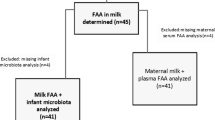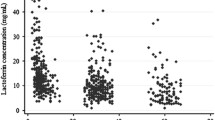Abstract
Lactoferrin (LF) is a natural component of human milk with antimicrobial, immunostimulatory and immunomodulatory properties. Several in vitro studies suggest that LF could promote an environment in the gut of neonates that favors colonization with beneficial bacteria. However, clinical studies on the correlation between the concentration of LF in breast milk and feces of infants and the gut microbiota in infants are lacking. In our study we analyzed the content of LF and the microbiota of breast milk and feces of infants of 48 mother–infant pairs (34 full-term and 14 pre-term infants) at birth and 30 days after delivery. In the term group, a significant decrease of mean LF concentration between colostrum (7.0 ± 5.1 mg/ml) and mature milk (2.3 ± 0.4 mg/ml) was observed. In pre-term group, breast milk LF levels were similar to those observed in full-term group. Fecal LF concentration of healthy infants was extremely high both in term and pre-term infants, higher than the amount reported in healthy children and adults. In term infants mean fecal LF levels significantly increased from birth (994 ± 1,828 μg/ml) to 1 month of age (3,052 ± 4,323 μg/ml). The amount of LF in the feces of 30 day-old term infants was significantly associated with maternal mature milk LF concentration (p = 0.030) confirming that breast milk represents the main source of LF found in the gut of infants. A linear positive correlation between colostrum and mature milk LF concentration was observed (p = 0.008) indicating that milk LF levels reflect individual characteristics. In pre-term infants higher mean concentrations of fecal LF at birth (1,631 ± 2,206 μg/ml) and 30 days after delivery (7,633 ± 9,960 μg/ml) were observed in comparison to full-term infants. The amount of fecal bifidobacteria and lactobacilli resulted associated with the concentration of fecal LF 3 days after delivery (p = 0.017 and p = 0.026, respectively). These results suggest that high levels of fecal LF in neonates, particularly in the first days of life, could represent an important factor in the initiation, development and/or composition of the neonatal gut microbiota. Since early host–microbe interaction is a crucial component of healthy immune and metabolic programming, high levels of fecal LF in neonates may beneficially contribute to the immunologic maturation and well-being of the newborn, especially in pre-term infants.





Similar content being viewed by others
References
Actor JK, Hwang SA, Kruzel ML (2009) Lactoferrin as a natural immune modulator. Curr Pharm Des 15:1956–1973
Balmer SE, Scott PH, Wharton BA (1989) Diet and faecal flora in the newborn: lactoferrin. Arch Dis Child 64:1685–1690
Bollard O, Marrow AL (2013) Human milk composition: nutrients and bioactive factors. Pediatr Clin North Am 60:49–74
Buccigrossi V, De Marco G, Bruzzese E, Ombrato L, Bracale I, Polito G, Guarino A (2007) Lactoferrin induces concentration-dependent functional modulation of intestinal proliferation and differentiation. Pediatr Res 61:410–414
Collado MC, Delgado S, Maldonado A, Rodríguez JM (2009) Assessment of the bacterial diversity of breast milk of healthy women by quantitative real-time PCR. Lett Appl Microbiol 48:523–528
Dominguez-Bello MG, Costello EK, Contreras M, Magris M, Hidalgo G, Fierer N, Knight R (2010) Delivery mode shapes the acquisition and structure of the initial microbiota across multiple body habitats in newborns. Proc Nati Acad Sci USA 107:11971–11975
Farnaud S, Evans RW (2003) Lactoferrin a multifunctional protein with antimicrobial properties. Mol Immunol 40:395–405
Heilig HGHJ, Zoetendal EG, Vaughan EE, Marteau P, Akkermans ADL, De Vos WM (2002) Molecular diversity of Lactobacillus spp. and other lactic acid bacteria in the human intestine as determined by specific amplification of 16S ribosomal DNA. Appl Environ Microbiol 68:114–123
Hentges DJ, MarshWW Petschow BW, Thal WR, Carter MK (1992) Influence of infant diets on the ecology of the intestinal tract of human flora-associated mice. J Pediatr Gastroenterol Nutr 14:146–152
Hooper LV, Macpherson AJ (2010) Immune adaptations that maintain homeostasis with the intestinal microbiota. Nat Immunol 10:159–169
Hu W, Zhao J, Wang J, Yu T, Wang J, Li N (2012) Transgenic milk containing recombinant human lactoferrin modulates the intestinal flora in piglets. Biochem Cell Biol. doi:10.1139/o2012-003
Huurre A, Kalliomaki M, Rautava S, Rinne M, Salminen S, Isolauri E (2008) Mode of delivery-effects on gut microbiota and humoral immunity. Neonatology 93:236–240
Jakaitis BM, Denning PW (2014) Commensal and probiotic bacteria may prevent NEC by maturing intestinal host defenses. Pathophysiology. doi:10.1016/j.pathophys.2013.11.012
Kim W-S, Tanaka T, Kumura H, Kim G-Y, Kwon I-K, Goh J-S et al (2004) Growth promoting effects of lactoferrin on L. acidophilus and Bifidobacterium spp. Biometals 17:279–283
Liepke C, Adermann K, Raida M, Magert HJ, Forssmann WG, Zucht HD (2002) Human milk provides peptides highly stimulating the growth of bifidobacteria. Eur J Biochem 269:712–718
Mai V, Torrazza RM, Ukhanova M, Wang X, Sun Y, Li N, Shuster J, Sharma R, Hudak ML, Neu J (2013) Distortions in development of intestinal microbiota associated with late onset sepsis in preterm infants. PLoS One 8(1):e52876. doi:10.1371/journal.pone.0052876
Manzoni P, Rinaldi M, Cattani S, Pugni L, Romeo MG, Messner H, Stolfi I, Decembrino L, Laforgia N, Vagnarelli F, Memo L, Bordignon L, Saia OS, Maule M, Gallo E, Mostert M, Magnani C, Quercia M, Bollani L, Pedicino R, Renzullo L, Betta P, Mosca F, Ferrari F, Magaldi R, Stronati M, Farina D (2009) Bovine lactoferrin supplementation for prevention of late-onset sepsis in very low-birth-weight neonates: a randomized trial. JAMA 7:1421–1428
Matsuki T, Watanabe K, Fujimoto J, Takada T, Tanaka R (2004) Use of 16S rRNA gene targeted group-specific primers for real-time PCR analysis of predominant bacteria in human feces. Appl Environ Microbiol 70:7220–7228
Miller-Catchpole R, Kot E, Haloftis G, Furmanov S, Bezkorovainy A (1997) Lactoferrin can supply iron for the growth of Bifidobacterium breve. Nutr Res 17:205–213
Newburg DS (2005) Innate immunity and human milk. J Nutr 135:1308–1312
Niemelä A, Kulomaa M, Vija P, Tuohimaa P, Saarikoski S (1989) Lactoferrin in human amniotic fluid. Hum Reprod 4:99–101
Otsuki K, Yoda A, Saito H, Mitsuhashi Y, Toma Y, Shimizu Y, Yanaihara T (1999) Amniotic fluid lactoferrin in intrauterine infection. Placenta 20:175–179
Petschow BW, Talbott RD, Batema RP (1999) Ability of lactoferrin to promote the growth of Bifidobacterium spp. in vitro is independent of receptor binding capacity and iron saturation level. J Med Microbiol 48:541–549
Rautava S, Luoto R, Salminen S, Isolauri E (2012) Microbial contact during pregnancy, intestinal colonization and human disease. Nat Rev Gastroenterol Hepatol 9:565–576
Roberts AK, Chierici R, Sawatzki G, Hill MJ, Volpato S, Vigi V (1992) Supplementation of an adapted formula with bovine lactoferrin: 1. Effect on the faecal flora. Acta Paediatr 81:119–124
Tomita S, Matsue M, Matsuyama J, Kiyosawa I (1994) Agglutination of bacterial cells of Clostridium innocuum, Bifidobacterium longum, and Micrococcus luteus by lactoferrin and ovotransferrin. Biosci Biotechnol Biochem 58:722–726
Torrazza RM, Ukhanova M, Wang X, Sharma R, Hudak ML, Neu J, Mai V (2013) Intestinal microbial ecology and environmental factors affecting necrotizing enterocolitis. PLoS One 8(12):e83304. doi:10.1371/journal.pone.0083304
Turroni F, Peano C, Pass DA, Foroni E, Severgnini M, Claesson MJ, Kerr C, Hourihane J, Murray D, Fuligni F, Gueimonde M, Margolles A, De Bellis G, O’Toole PW, van Sinderen D, Marchesi JR, Ventura M (2012) Diversity of bifidobacteria within the infant gut microbiota. PLoS One. doi:10.1371/journal.pone.0036957
Walker TR, Land ML, Kartashov A, Saslowsky TM, Lyerly DM, Boone JH, Rufo PA (2007) Fecal lactoferrin is a sensitive and specific marker of disease activity in children and young adults with inflammatory bowel disease. J Pediatr Gastroenterol Nutr 44:414–422
Zivkovic AM, German JB, Lebrilla CB, Mills DA (2011) Human milk glycobiome and its impact on the infant gastrointestinal microbiota. PNAS 108:4653–4658
Author information
Authors and Affiliations
Corresponding author
Rights and permissions
About this article
Cite this article
Mastromarino, P., Capobianco, D., Campagna, G. et al. Correlation between lactoferrin and beneficial microbiota in breast milk and infant’s feces. Biometals 27, 1077–1086 (2014). https://doi.org/10.1007/s10534-014-9762-3
Received:
Accepted:
Published:
Issue Date:
DOI: https://doi.org/10.1007/s10534-014-9762-3




